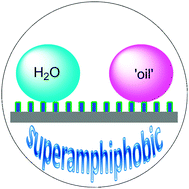Superamphiphobic surfaces
Abstract
Superamphiphobicity is an effect where surface roughness and surface chemistry combine to generate surfaces which are both superhydrophobic and superoleophobic, i.e., contact angles (θCA) greater than 150° along with low contact angle hysteresis (CAH) not only towards probing water but also for low-surface-tension ‘oils’. In this review, we summarize the research on superamphiphobic surfaces, including the characterization of superamphiphobicity, different techniques towards the fabrication of surface roughness and surface modification with low-surface-energy materials as well as their functional applications.


 Please wait while we load your content...
Please wait while we load your content...